AquaCrop Simulation of Winter Wheat under Different N Management Practices
Abstract
:1. Introduction
2. Materials and Methods
2.1. Field Experiments and Data
2.2. Soil Moisture Measurement Network
2.3. AquaCrop Model Description
2.4. Simulation Procedure
- (i)
- The evaluation aimed at the effectiveness of AquaCrop to simulate the soil water content evolution and crop yield in different areas of an experimental field under different treatments. Two soil water content profiles (up to 1 m depth) in the 2015–2016 growing season and four profiles in the 2016–2017 growing season were used (Figure 3). Table 2 present the conservative and the nonconservative parameters used for the simulations during the two growing seasons. The model was adjusted to crop yield (kg/ha) as measured in plot samples. Measurement of soil water content is a prerequisite for establishing a reliable water balance at the field scale.
- (ii)
- AquaCrop was evaluated to estimate the wheat yield under different treatments. The simulation was a two-step procedure: (a) simulations at field positions with 30 cm soil moisture sensors (blocks/repetitions 2 and 3) were used to determine soil water content evolution, yield, and average fertility per zone and treatment (Calibration of the model); (b) using these fertility levels and local soil data, crop production was estimated in other parts of the field with available yield data (blocks/repetitions 1 and 4) under different N treatments. The simulated yields were compared to the field yields (Validation of the model). For the simulation, we used the default in the AquaCrop wheat.cro file (Valenzano).
3. Results
3.1. Meteorological and Soil Conditions
3.2. Simulation: Model Calibration and Validation
4. Discussion
4.1. Simulations Using the 100 cm Soil Moisture Profile
4.2. Simulations in All the Zones of the Field for Yield Estimation
5. Conclusions
Author Contributions
Funding
Institutional Review Board Statement
Informed Consent Statement
Data Availability Statement
Acknowledgments
Conflicts of Interest
References
- Köppen, W. Das geographische System der Klimate [The geographic system of climates]. In Handbuch der Klimatologie; Verlag von Gebrüder Borntraeger: Berlin, Germany, 1936. [Google Scholar]
- Steduto, P.; Hsiao, T.; Fereres, E.; Raes, D. Crop Yield Response to Water; FAO Paper No. 66; FAO: Rome, Italy, 2012. [Google Scholar]
- Doorenbos, J.; Kasssam, A.H. Yield Response to Water; FAO Irrigation and Drainage Paper No. 33; FAO: Rome, Italy, 1979. [Google Scholar]
- Steduto, P.; Hsiao, T.; Fereres, E. On the conservative behavior of biomass water productivity. Irrig. Sci. 2007, 25, 189–207. [Google Scholar] [CrossRef] [Green Version]
- Mustafa, S.M.T.; Vanuytrecht, E.; Huysmans, M. Combined deficit irrigation and soil fertility management on different soil textures to improve wheat yield in drought-prone Bangladesh. Agric. Water Manag. 2017, 191, 124–137. [Google Scholar] [CrossRef]
- Farahani, H.J.; Izzi, G.; Oweis, T.Y. Parameterization and evaluation of the AquaCrop model for full and deficit irrigated cotton. Agron. J. 2009, 101, 469–476. [Google Scholar] [CrossRef] [Green Version]
- García-Vila, M.; Fereres, E.; Mateos, L.; Orgaz, F.; Steduto, P. Deficit irrigation optimization of cotton with AquaCrop. Agron. J. 2009, 101, 477–487. [Google Scholar] [CrossRef]
- Geerts, S.; Raes, D.; Garcia, M.; Miranda, R.; Cusicanqui, J.A.; Taboada, C.; Mendoza, J.; Huanca, R.; Mamani, A.; Condori, O.; et al. Simulating yield response of Quinoa to water availability with AquaCrop. Agron. J. 2009, 101, 499–508. [Google Scholar] [CrossRef]
- Geerts, S.; Raes, D.; Garcia, M.; Taboada, C.; Miranda, R.; Cusicanqui, J.; Mhizha, T.; Vacher, J. Modeling the potential for closing quinoa yield gaps under varying water availability in the Bolivian Altiplano. Agric. Water Manag. 2009, 96, 1652–1658. [Google Scholar] [CrossRef]
- Heng, L.K.; Evett, S.R.; Howell, T.A.; Hsiao, T.C. Validating the FAO AquaCrop model for irrigated and water deficit field maize. Agron. J. 2009, 101, 488–498. [Google Scholar] [CrossRef] [Green Version]
- Hsiao, T.C.; Heng, L.K.; Steduto, P.; Rojas, B.; Raes, D.; Fereres, E. AquaCrop—The FAO crop model to simulate yield response to water: III. Parameterization and testing for maize. Agron. J. 2009, 101, 448–459. [Google Scholar] [CrossRef]
- Maniruzzaman, M.; Talukder, M.S.U.; Khan, M.H.; Biswas, J.C.; Nemes, A. Validation of the AquaCrop model for irrigated rice production under variedwater regimes in Bangladesh. Agric. Water Manag. 2015, 159, 331–340. [Google Scholar] [CrossRef]
- Todorovic, M.; Albrizio, R.; Zivotic, L.; Abi-Saab, M.T.; Stockle, C.; Steduto, T.C. Assessment of AquaCrop, CropSyst, and WOFOST, models in the simulation ofsunflower growth under different water regimes. Agron. J. 2009, 101, 509–521. [Google Scholar] [CrossRef]
- Rahimikhoob, H.; Sohrabi, T.; Delshad, M. Simulating crop response to Nitrogen-deficiency stress using the critical Nitrogen concentration concept and the AquaCrop semi-quantitative approach. Sci. Hortic. 2021, 285, 110194. [Google Scholar] [CrossRef]
- Raes, D.; Steduto, P.; Hsiao, T.C.; Fereres, E. AquaCrop–The FAO crop model to simulate yield response to water: II. Main algorithms and software description. Agron. J. 2009, 101, 438–447. [Google Scholar] [CrossRef] [Green Version]
- Steduto, P.; Hsiao, T.C.; Raes, D.; Fereres, E. AquaCrop—the FAO crop model to simulate yield response to water: I. Concepts and underlying principles. Agron. J. 2009, 101, 426–437. [Google Scholar] [CrossRef] [Green Version]
- Vanuytrecht, E.; Raes, D.; Steduto, P.; Hsiao, T.C.; Fereres, E.; Heng, L.K.; Garcia-Vila, M.; Moreno, P.M. AquaCrop: FAO’s crop water productivity and yield response model. Environ. Model. Softw. 2014, 62, 351–360. [Google Scholar] [CrossRef]
- Vanuytrecht, E.; Raes, D.; Willems, P. Considering sink strength to modelcrop production under elevated atmospheric CO2. Agric. For. Meteorol. 2011, 151, 1753–1762. [Google Scholar] [CrossRef]
- Vanuytrecht, E.; Raes, D.; Willems, P. Global sensitivity analysis of yield output from the water productivity model. Environ. Model. Softw. 2014, 51, 323–332. [Google Scholar] [CrossRef] [Green Version]
- Vanuytrecht, E.; Raes, D.; Willems, P.; Semenov, M. Comparing climate change impacts on cereals based on CMIP3 and EU-ENSEMBLES climate scenarios. Agric. For. Meteorol. 2014, 195–196, 12–23. [Google Scholar] [CrossRef]
- Vanuytrecht, E.; Raes, D.; Willems, P. Regional and global climate projections increase mid-century yield variability and crop productivity in Belgium. Reg. Environ. Chang. 2016, 16, 659–672. [Google Scholar] [CrossRef] [Green Version]
- Stricevic, R.; Cosic, M.; Djurovic, N.; Pejic, B.; Maksimovic, L. Assessment of the FAO AquaCrop model in simulation of rainfed and supplementally irrigated maize, sugar beet and sunflower. Agric. Water Manag. 2011, 98, 1615–1621. [Google Scholar] [CrossRef]
- Katerji, N.; Campi, P.; Mastrorilli, M. Productivity, evapotranspiration, andwater use efficiency of corn and tomato crops simulated by AquaCrop under contrasting water stress conditions in the Mediterranean region. Agric. Water Manag. 2013, 130, 14–26. [Google Scholar] [CrossRef]
- Hussein, F.; Janat, M.; Yakoub, A. Simulating cotton yield response to deficit irrigation with the FAO AquaCrop model. Span. J. Agric. Res. 2011, 9, 1319–1330. [Google Scholar] [CrossRef] [Green Version]
- Abedinpour, M.; Sarangi, A.; Rajput, T.B.S.; Singh, M.; Pathak, H.; Ahmad, T. Performance evaluation of AquaCrop Model for maize crop in a semi-arid environment. Agric. Water Manag. 2012, 110, 55–66. [Google Scholar] [CrossRef]
- Shrestha, N.; Raes, D.; Vanuytrecht, E.; Sah, S.K. Cereal yield stabilization in Terai (Nepal) by water and soil fertility management modeling. Agric. Water Manag. 2013, 122, 53–62. [Google Scholar] [CrossRef]
- Shirazi, S.Z.; Mei, X.; Liu, B.; Liu, Y. Estimating potential yield and change in water budget for wheat and maize across Huang-Huai-Hai Plain in the future. Agric. Water Manag. 2022, 260, 107282. [Google Scholar] [CrossRef]
- Hassan, D.F.; Ati, A.S.; Neima, A.S. Calibration and Evaluation of AquaCrop for Maize (Zea Mays, L.) under Different Irrigation and Cultivation Methods. J. Ecol. Eng. 2021, 22, 192–204. [Google Scholar] [CrossRef]
- Abrha, B.; Delbecque, N.; Raes, D.; Tsegay, A.; Todorovic, M.; Heng, L.E.E.; Vanutrecht, E.; Geerts, S.A.M.; Garcia-Vila, M.; Deckers, S. Sowing strategies for barley (Hordeum vulgare L.) based on modelled yield response towater with AquaCrop. Exp. Agric. 2012, 48, 252–271. [Google Scholar] [CrossRef] [Green Version]
- Tsegay, A.; Raes, D.; Geerts, S.; Vanuytrecht, E.; Abraha, B.; Deckers, J.; Bauer, H.; Gebrehiwot, K. Unravelling crop water productivity of tef (Eragrostis Tef (Zucc.) Trotter) through AquaCrop in northern Ethiopia. Exp. Agric. 2012, 48, 222–237. [Google Scholar] [CrossRef]
- Tsegay, A.; Vanuytrecht, E.; Abrha, B.; Deckers, J.; Gebrehiwot, K.; Raes, D. Sowing and irrigation strategies for improving rainfed tef (Eragrostis tef (Zucc.) Trotter) production in the water scarce Tigray region, Ethiopia. Agric. Water Manag. 2015, 150, 81–91. [Google Scholar] [CrossRef]
- Adeboye, O.B.; Schultz, B.; Adekalu, K.O.; Prasad, K. Modelling of response of the growth and yield of soybean to full and deficit irrigation by using Aquacrop. Irrig. Drain. 2017, 66, 192–205. [Google Scholar] [CrossRef]
- Adeboye, O.B.; Schultz, B.; Adeboye, A.P.; Adekalu, K.O.; Osunbitan, J.A. Application of the AquaCrop model in decision support for optimization of nitrogen fertilizer and water productivity of soybeans. Inf. Process. Agric. 2021, 8, 419–436. [Google Scholar] [CrossRef]
- Andarzian, B.; Bannayan, M.; Steduto, P.; Mazraeh, H.; Barati, M.E.; Barati, M.A.; Rahnama, A. Validation and testing of the AquaCrop model under full and deficit irrigated wheat production in Iran. Agric. Water Manag. 2011, 100, 1–8. [Google Scholar] [CrossRef]
- Mkhabela, M.S.; Bullock, P.R. Performance of the FAO AquaCrop model for wheat grain yield and soil moisture simulation in Western Canada. Agric. Water Manag. 2012, 110, 16–24. [Google Scholar] [CrossRef]
- Singh, A.; Saha, S.; Mondal, S. Modelling irrigated wheat production using the FAO AquaCrop model in West Bengal, India, for sustainable agriculture. Irrig. Drain. 2013, 62, 50–56. [Google Scholar] [CrossRef]
- Toumi, J.; Er-Raki, S.; Ezzahar, J.; Khabba, S.; Jarlan, L.; Chehbouni, A. Performance assessment of AquaCrop model for estimating evapotranspiration, soil water content and grain yield of winter wheat in Tensift Al Haouz (Morocco): Application to irrigation management. Agric. Water Manag. 2016, 163, 219–235. [Google Scholar] [CrossRef]
- Islam, T.A.F.M.; Islam, S.A.K.M.; Islam, T.G.M.; Bala, S.K.; Salehin, M.; Choudhury, A.K.; Dey, N.C.; Hossain, A. Adaptation strategies to increase water productivity of wheat under changing climate. Agric. Water Manag. 2022, 264, 107499. [Google Scholar] [CrossRef]
- Abedinpour, M. The Comparison of DSSAT-CERES and AquaCrop Models for Wheat Under Water–Nitrogen Interactions. Commun. Soil Sci. Plant Anal. 2021, 52, 2002–2017. [Google Scholar] [CrossRef]
- Abdou, S.M.M.; Engel, B.A.; Emam, S.M.; Abd El-Latif, K.M. AquaCrop Model Validation for Simulation Wheat Productivity under Water Stress Condition, Communications. Soil Sci. Plant Anal. 2022, 53, 281–292. [Google Scholar] [CrossRef]
- Amiri, E.; Bahrani, A.; Irmak, S.; Mohammadiyan Roshan, N. Evaluation of irrigation scheduling and yield response for wheat cultivars using the AquaCrop model in an arid climate. Water Supply 2021, 22, 602. [Google Scholar] [CrossRef]
- Bello, Z.A.; Walker, S. Evaluating AquaCrop model for simulating production of amaranthus (Amaranthus cruentus) a leafy vegetable, under irrigation and rainfed Conditions. Agric. For. Meteorol. 2017, 247, 300–310. [Google Scholar] [CrossRef]
- Araya, A.; Habtu, S.; Hadgu, K.M.; Kebede, A.; Dejene, T. Test of AquaCrop model in simulating biomass and yield of water deficient and irrigated barley (Hordeum vulgare). Agric. Water Manag. 2010, 97, 1838–1846. [Google Scholar] [CrossRef]
- Araya, A.; Keesstra, S.D.; Stroosnijder, L. Simulating yield response to water of Teff (Eragrostis tef) with FAO’s AquaCrop model. Field Crops Res. 2010, 116, 196–204. [Google Scholar] [CrossRef]
- Van Gaelen, H.; Tsegay, A.; Delbecque, N.; Shrestha, N.; Garcia, M.; Fajardo, H.; Miranda, R.; Vanuytrecht, E.; Abrha, B.; Diels, J.; et al. A semi-quantitative approach for modelling crop response to soil fertility: Evaluation of the AquaCrop procedure. J. Agric. Sci. 2014, 153, 1218–1233. [Google Scholar] [CrossRef]
- Akumaga, A.; Tarhule, A.; Yusuf, A.A. Validation and testing of the FAO AquaCrop model under different levels of nitrogen fertilizer on rainfed maize in Nigeria, West Africa. Agric. For. Meteorol. 2017, 232, 225–234. [Google Scholar] [CrossRef]
- Holland, K.H.; Schepers, J.S. Derivation of a variable rate nitrogen application model for in-season fertilization of corn. Agron. J. 2010, 102, 1415–1424. [Google Scholar] [CrossRef]
- European Parliament. Directive 2000/60/EC of the European Parliament and of the Council of 23 October 2000 establishing a framework for Community action in the field of water policy. Off. J. L 2000, 327, 1–90. [Google Scholar]
- Polychronaki, E.; Douma, C.; Giourga, C.; Loumou, A. Assessing Nitrogen Fertilization Strategies in Winter Wheat and Cotton Crops in Northern Greece. Pedosphere 2012, 22, 689–697. [Google Scholar] [CrossRef]
- Stamatiadis, S.; Schepers, J.S.; Evangelou, E.; Tsadilas, C.; Glampedakis, A.; Glampedakis, M.; Dercas, N.; Spyropoulos, N.; Dalezios, N.R.; Eskridge, K. Variable-rate nitrogen fertilization of winter wheat under high spatial resolution. Precis. Agric. 2018, 19, 570–587. [Google Scholar] [CrossRef]
- Dercas, N.; Dalezios, N.; Evangelou, E.; Stamatiadis, S.; Glambedakis, A.; Mantonanakis, G.; Tserlikakis, N. Wheat simulation using Aqua Crop model in precision agriculture. In Proceedings of the 6th Congress on Soil and Water Resources with International Participation, Menemen, Turkey, 12–14 November 2019. [Google Scholar]
- Bouyoukos, G.H. A recalibration of the hydrometer method for making mechanical analysis of soils. Agron. J. 1951, 43, 434–438. [Google Scholar] [CrossRef] [Green Version]
- Nelson, D.W.; Sommers, L.E. Total carbon, organic carbon, and organic matter. In Methods of Soil Analysis, Part 2, 2nd ed.; Page, A.L., Miller, R.H., Keeney, D.R., Eds.; Academic Press: Cambridge, MA, USA, 1982; pp. 539–579. [Google Scholar]
- Bremner, J.M.; Mulvaney, C.S. Nitrogen-total. In Methods of Soil Analysis, Part 2, Chemical and Microbiological Properties, 2nd ed.; Page, A.L., Miller, R.H., Keeney, D.R., Eds.; American Society of Agronomy and Soil Science Society of America, Inc.: Madison, WI, USA, 1982; pp. 595–624. [Google Scholar]
- Thomas, G.W. Exchangeable cations. In Methods of Soil Analysis, Part 2, Chemical and Microbiological Properties; Series Agronomy No. 9; Page, A.L., Miller, R.H., Keeney, D.R., Eds.; ASA and SSSA: Madison, WI, USA, 1982; pp. 159–165. [Google Scholar]
- Olsen, S.R.; Sommers, L.E. Phosphorus. In Methods of Soil Analysis, Part 2: Chemical and Microbiological Properties, 2nd ed.; Page, A.L., Miller, R.H., Keeney, D.R., Eds.; ASA and SSSA: Madison, WI, USA, 1982; pp. 403–430. [Google Scholar]
- FAO. Irrigation and Drainage Paper N. 49; CLIMWAT, A Climatic Database; FAO: Rome, Italy, 1994. [Google Scholar]
- Soulis, K.X.; Elmaloglou, S.; Dercas, N. Investigating the effects of soil moisture sensors positioning and accuracy on soil moisture based drip irrigation scheduling systems. Agric. Water Manag. 2015, 148, 258–268. [Google Scholar] [CrossRef]
- Foster, T.; Brozovic, N.; Butler, A.P.; Neale, C.M.U.; Raes, D.; Steduto, P.; Fereres, E.; Hsiao, T.C. AquaCrop-OS: An open source version of FAO’s crop water productivity model. Agric. Water Manag. 2017, 181, 18–22. [Google Scholar] [CrossRef]
- Steduto, P.; Raes, D.; Hsiao, T.; Fereres, E.; Heng, L.; Izzi, G.; Hoogeveen, J. AquaCrop: A new model for crop prediction under water deficit conditions. In Drought Management: Scientific and Technological Innovations; López-Francos, A., Ed.; CIHEAM: Zaragoza, Spain, 2008. [Google Scholar]
- Raes, D.; Steduto, P.; Hsiao, T.; Fereres, E. AquaCrop Version 6.0–6.1, Reference Manual; FAO: Rome, Italy, 2018. [Google Scholar]
- Mabhaudhi, T.; Modi, A.T.; Beletse, Y.G. Parameterisation and evaluation of the FAO-AquaCrop model for a South African taro (Colocasia esculenta L. Schott) landrace. Agric. For. Meteorol. 2014, 192–193, 132–139. [Google Scholar] [CrossRef]
- Allen, R.G.; Pereira, L.S.; Raes, D.; Smith, M. Crop Evapotranspiration. Guidelines for Computing Crop Water Requirements; FAO Irrigation and Drainage Paper No. 56; FAO: Rome, Italy; 333p.
- United States Department of Agriculture—USDA. Soil, Plant, Atmosphere, Water, Field & Pond Hydrology Model; USDA Agricultural Research Service: Beltsville, MD, USA, 2007. [Google Scholar]
- Akbari, A.; Samah, A.; Ngien, S. Effect of slope adjustment on curve number using global digital elevation data: New look into Sharply Williams and Huang Methods. In Proceedings of the Second International Conference on Science, Engineering & Environment, Osaka, Japan, 21–23 November 2016. [Google Scholar]
- Mebane, V.J.; Day, R.L.; Hamlett, J.M.; Watson, J.E.; Roth, G.W. Validating the FAO AquaCrop model for rainfed maize in Pennsylvania. Agron. J. 2013, 105, 419–427. [Google Scholar] [CrossRef]
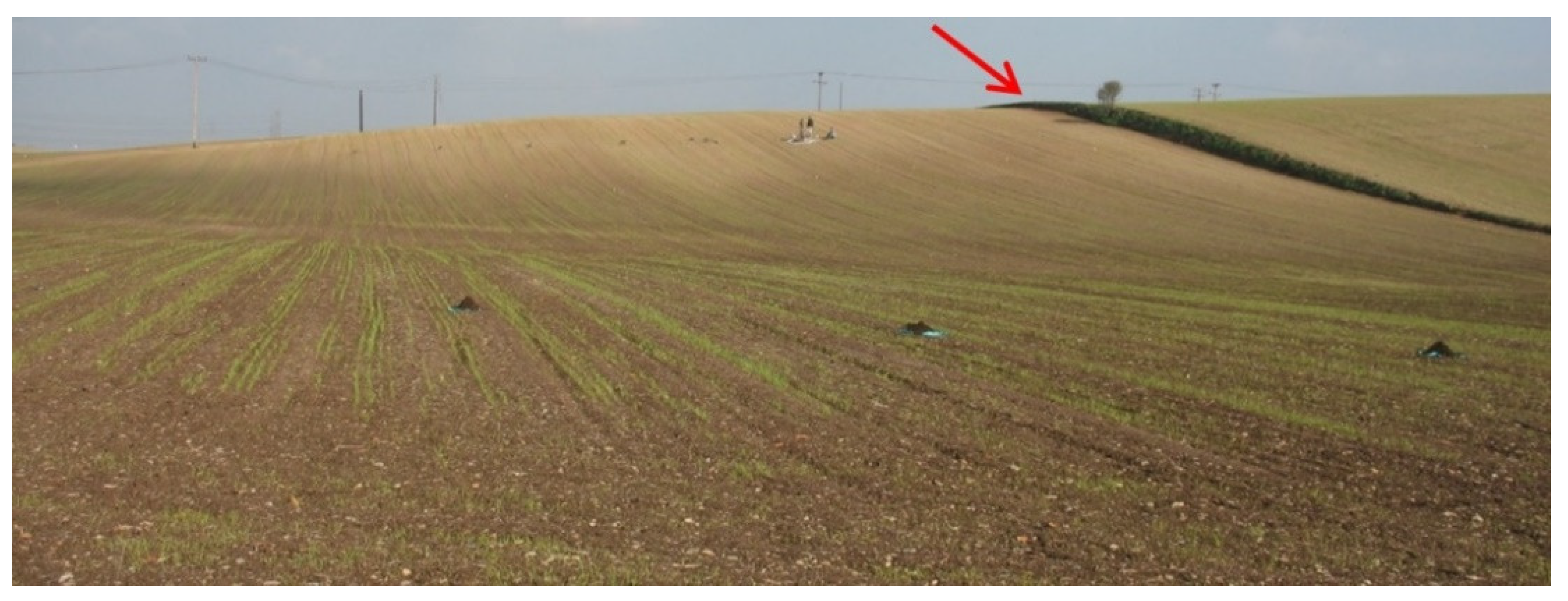
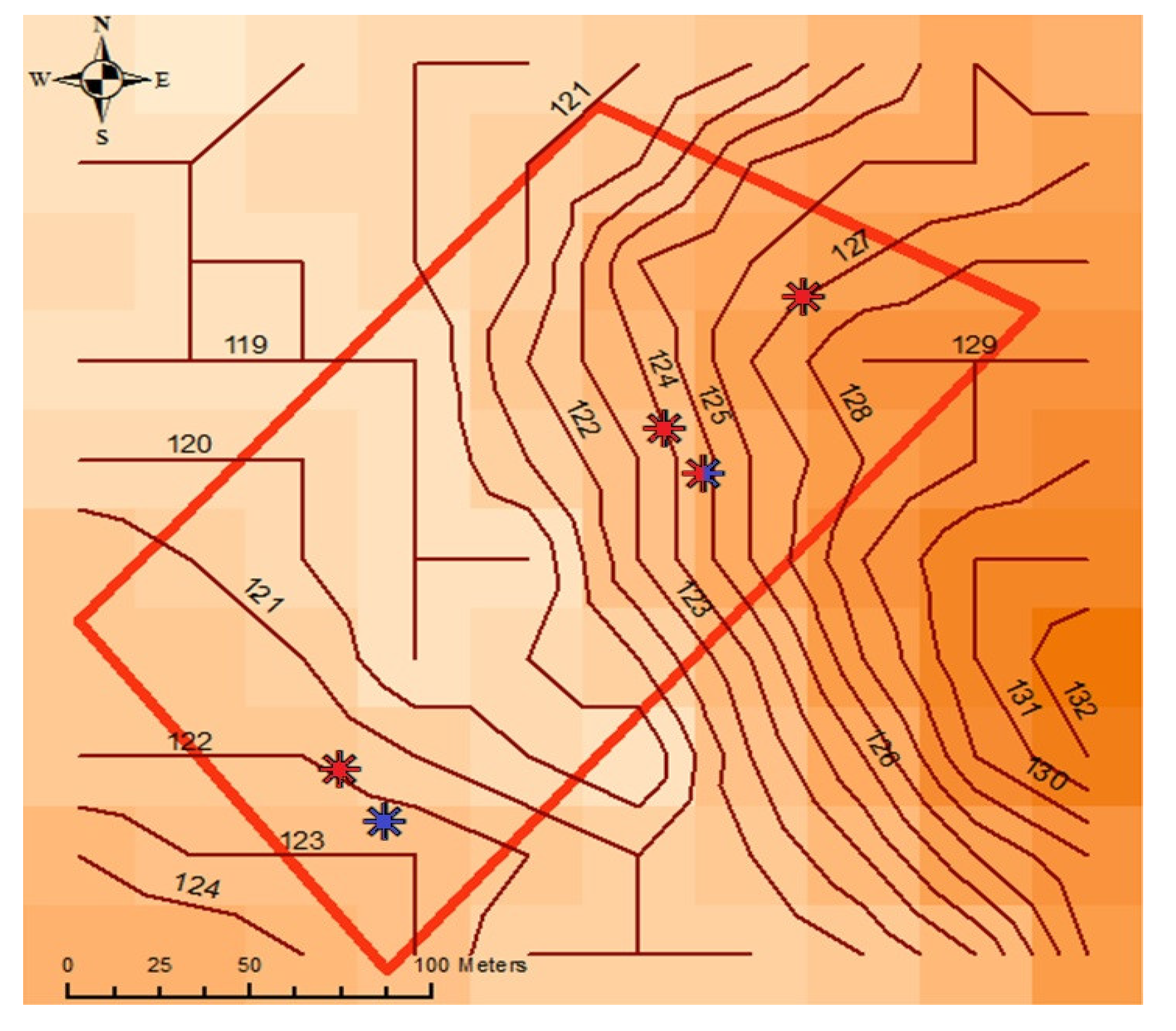
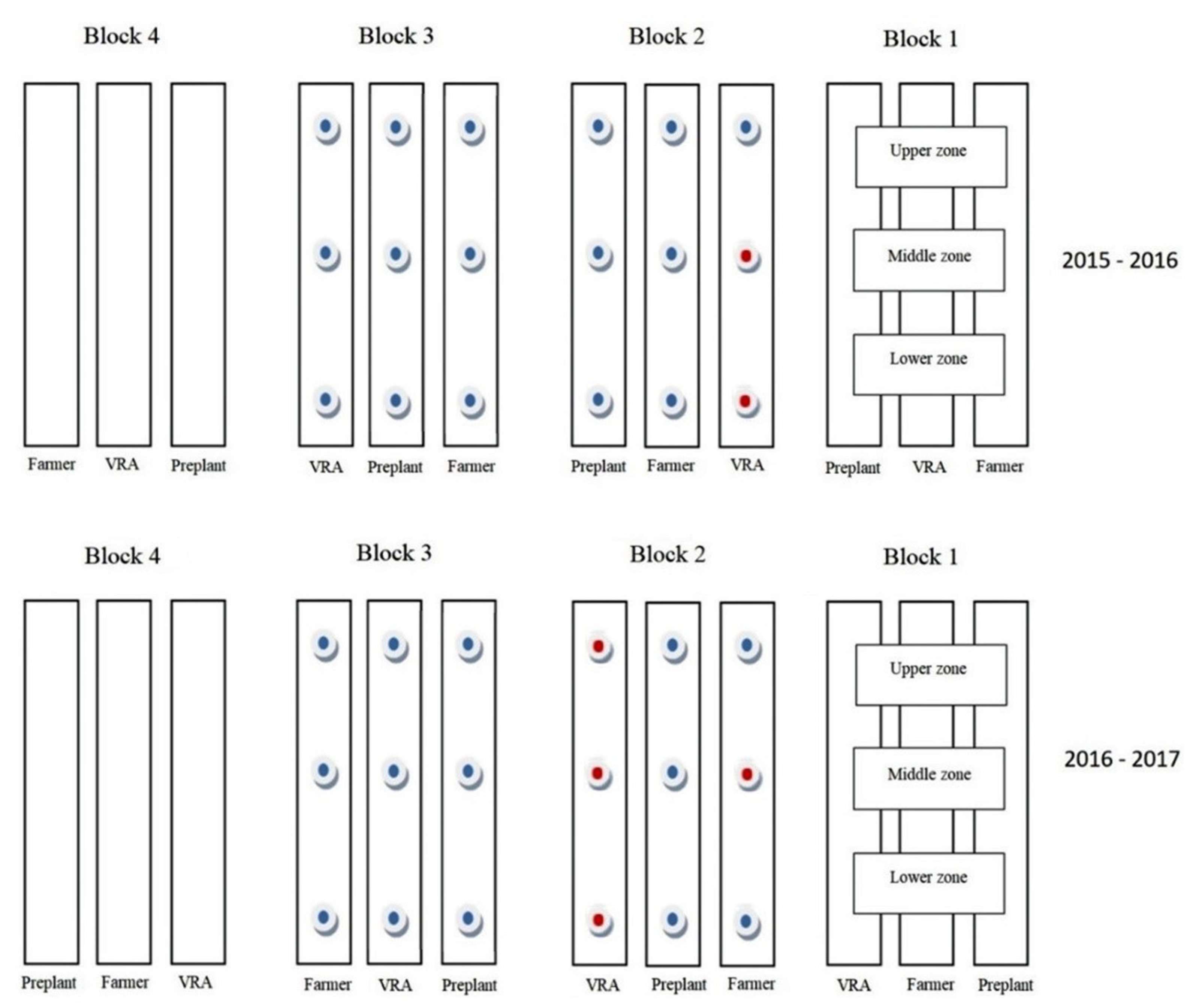
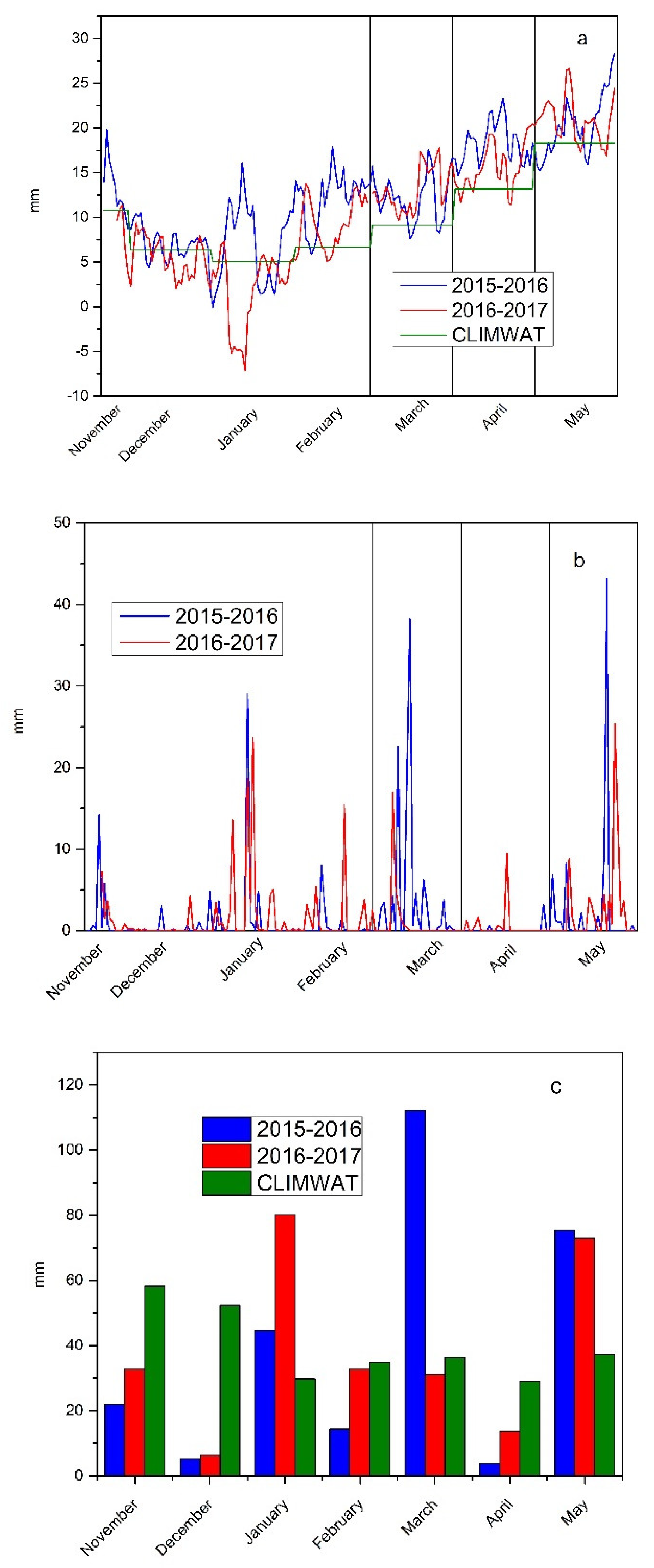
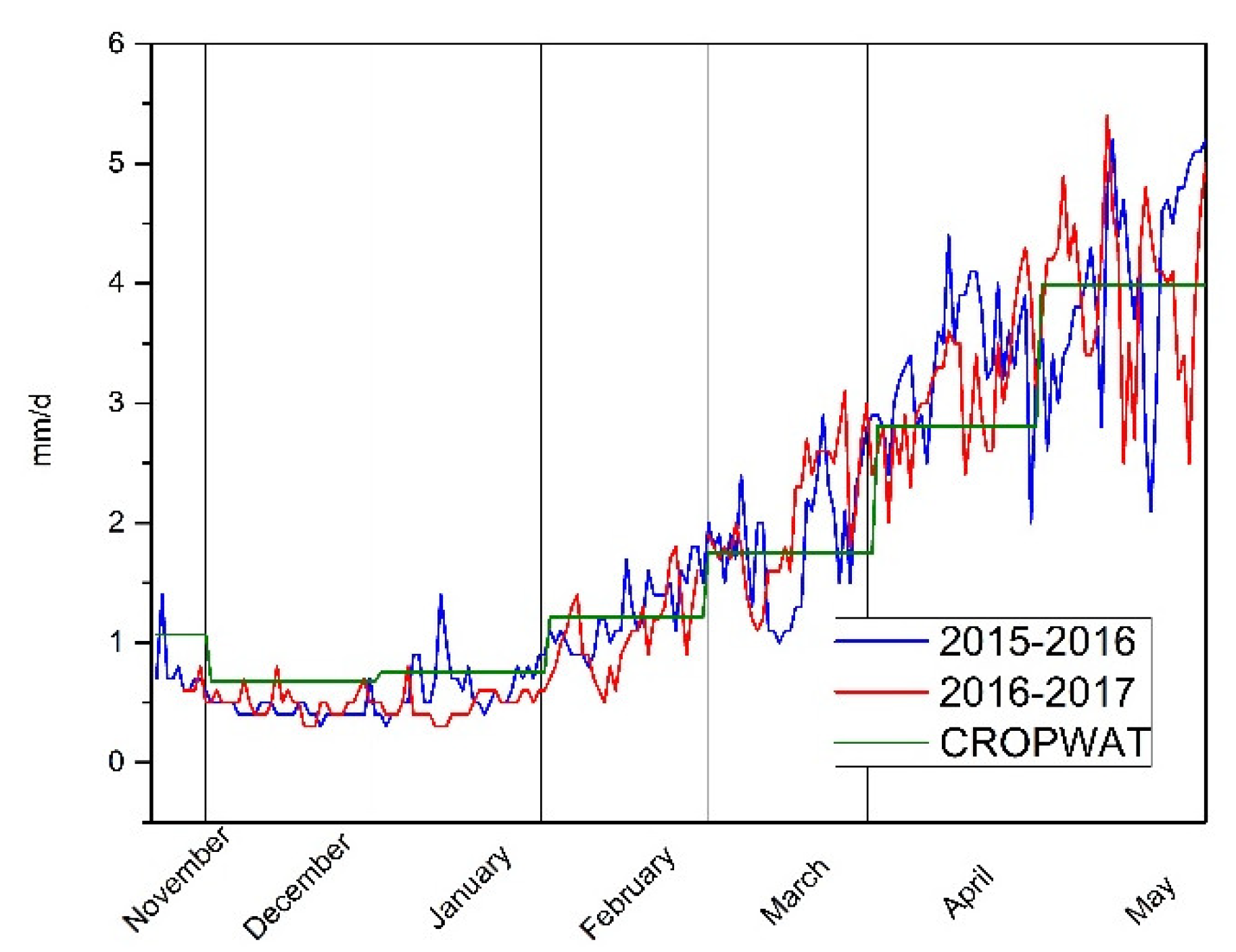


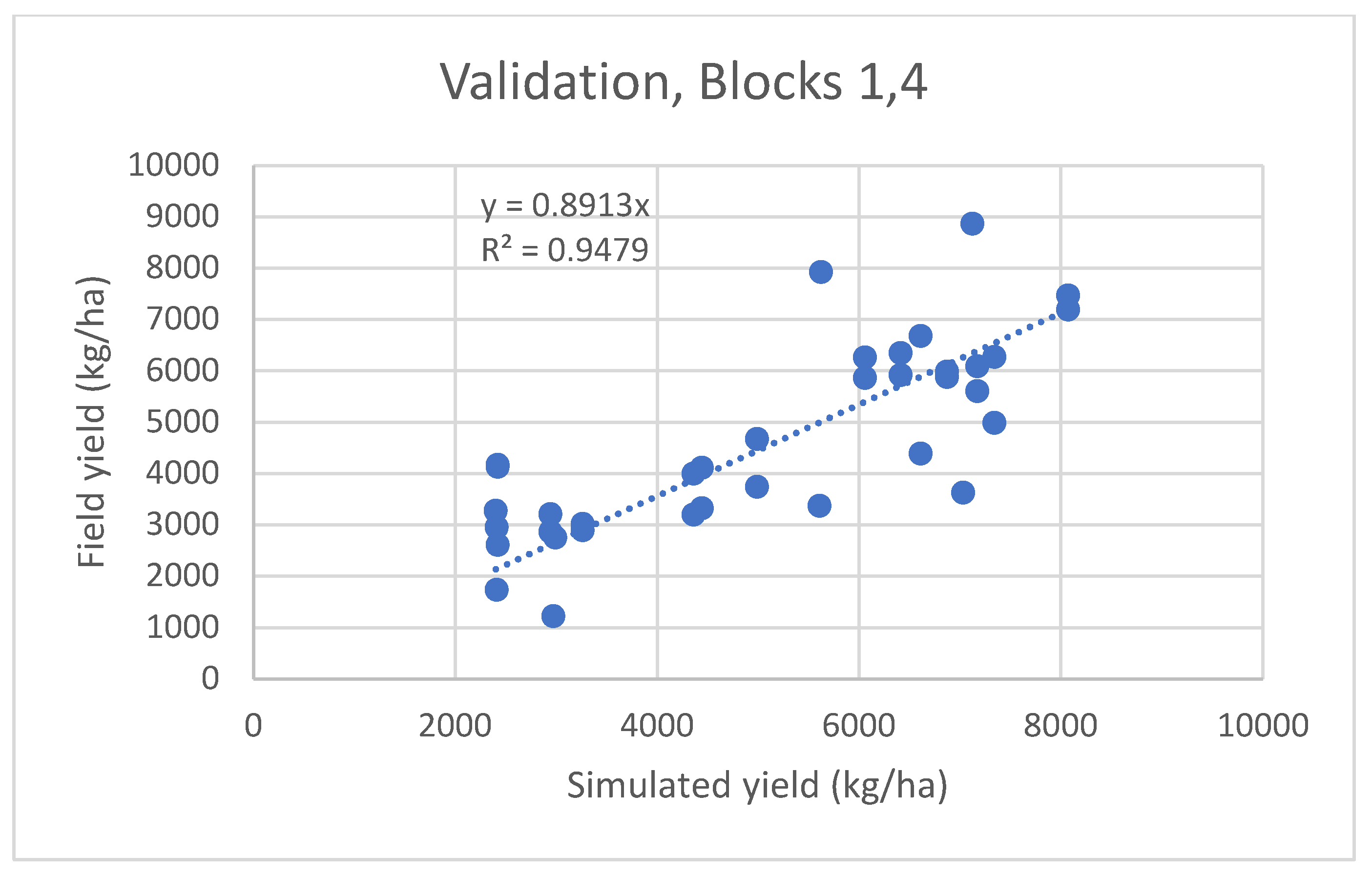

| Landscape Position | ||||
|---|---|---|---|---|
| Soil Depths (cm) | Soil Properties | Lower Zone | Middle Zone ZoneSlope | Upper Zone Land |
| 0–20 | Sand (%) | 38.0 | 43.8 | 34.3 |
| Clay (%) | 44.4 | 36.3 | 46.7 | |
| Silt (%) | 17.6 | 19.9 | 19.1 | |
| SOM (%) | 2.02 | 1.44 | 1.87 | |
| CaCO3 (%) | 5.4 | 26.3 | 35.2 | |
| Total N (%) | 0.122 | 0.095 | 0.107 | |
| P-Olsen (mg/kg) | 7.54 | 5.68 | 8.00 | |
| K (cmol/kg) | 0.80 | 0.44 | 0.48 | |
| 20–40 | Sand (%) | 40.1 | 47.9 | 31.4 |
| Clay (%) | 42.1 | 35.4 | 48.5 | |
| Silt (%) | 17.8 | 16.7 | 19.8 | |
| SOM (%) | 1.68 | 1.29 | 1.60 | |
| CaCO3 (%) | 5.1 | 24.5 | 41.5 | |
| Total N (%) | 0.108 | 0.087 | 0.098 | |
| P-Olsen (mg/kg) | 3.69 | 3.53 | 5.38 | |
| K (cmol/kg) | 0.65 | 0.39 | 0.39 | |
| A. Conservative Crop Parameters | |
|---|---|
| Base temperature (°C) below which crop development does not progress | 0.0 |
| Upper temperature (°C) above which crop development no longer increases with an increase in temperature | 26.0 |
| Crop coefficient when canopy is complete but prior to senescence (KcTr, x) | 1.10 |
| Water productivity normalized for ETo and CO2 (WP*) (g/m2) | 15.0 |
| Possible increase (%) in HI due to water stress before flowering | 5 |
| Coefficient describing positive impact on HI of restricted vegetative growth during yield formation | 10.0 |
| Coefficient describing negative impact on HI of stomatal closure during yield formation | 7.0 |
| Allowable maximum increase (%) in specified HI | 15 |
| Soil water depletion factor for canopy expansion (p-exp)—Upper threshold | 0.20 |
| Soil water depletion factor for canopy expansion (p-exp)—Lower threshold | 0.65 |
| Soil water depletion fraction for stomatal control (p-sto)—Upper threshold | 0.65 |
| Soil water depletion factor for canopy senescence (p-sen)—Upper threshold | 0.70 |
| Minimum growing degrees required for full crop transpiration (°C—day) | 14.0 |
| B. Fine-Tuned Non-conservative Parameters | |
| Number of Plants per Hectare | 185,000 |
| Degree Days: from sowing to emergence | 150 |
| Degree Days: from sowing to max. canopy | 1186 |
| Degree Days: from sowing to flowering | 1250 |
| Degree Days: from sowing to senescence | 1700 |
| Degree Days: from sowing to maturity | 2400 |
| Maximum canopy cover (CCx) in fraction soil cover | 0.96 |
| Maximum effective rooting depth (m) | 1.00 |
| Average root zone expansion (cm/day) | 0.9 |
| Reference Harvest Index (HIo) (%) | 48 |
| Field zone | Block4 | Block3 | Block2 | Block1 | ||||||||
| (0–20) cm | ||||||||||||
| Preplant | Farmer | VRT | Farmer | VRT | Preplant | VRT | Preplant | Farmer | VRT | Farmer | Preplant | |
| Upper | C | C | C | C | C | SC | C | C | C/CL | C/CL | CL | C |
| Middle | C | C | C | SCL | CL/SCL | SC/CL | CL | SC/SCL | SC/CL/SCL | SCL | L | SC/SCL |
| Lower | CL | C | CL | C | C | C | C | C | C | C | C | C |
| (20–40) cm | ||||||||||||
| Upper | C | C | C | C | C | C/SC | SC | C | CL | CL | SC | SC/CL |
| Middle | CL | C | C | SC/SCL | CL | SCL | SCL | C | SCL | SCL | SCL | SC |
| Lower | C | C | CL | C | C | C | C | C | C | C | C | C |
| Treatment | Measured Yield (kg/ha) | Simulated Yield (kg/ha) | Fertility Level |
|---|---|---|---|
| 2015–2016 VRA low | 9220 | 8793 | 100% |
| 2015–2016 VRA mid | 5380 | 5410 | 59% |
| 2016–2017 VRA low | 5340 | 5336 | 72% |
| 2016–2017 VRA mid | 2070 | 2115 | 24% |
| 2016–2017 Farm mid | 1860 | 1835 | 21% |
| 2016–2017 VRA up | 3020 | 3010 | 34% |
| Treatment | E (mm) | T (mm) | R (mm) | D (mm) | R |
|---|---|---|---|---|---|
| 2015–2016 VRA low | 43 | 250.2 | 32.6 | 39.8 | 0.58 |
| 2015–2016 VRA mid | 77.7 | 201.8 | 22.7 | 52.9 | 0.82 |
| 2016–2017 VRA low | 106.7 | 216.1 | 12.8 | 8.2 | 0.95 |
| 2016–2017 VRA mid | 162 | 134.4 | 15.2 | 16 | 0.89 |
| 2016–2017 Farm mid | 168.8 | 120.5 | 15.7 | 57.1 | 0.94 |
| 2016–2017 VRA up | 118.5 | 206.3 | 30.3 | 0 | 0.82 |
| Lowland | Slope | Upland | |||||||||||
|---|---|---|---|---|---|---|---|---|---|---|---|---|---|
| 2015–2016 Cult. Per. | Treatment | Yield Meas | Fertility | YieldSim | Average Fertility | Yield Meas | Fertility | YieldSim | Average Fertility | Yield Meas | Fertility | YieldSim | Average Fertility |
| Block2 | Preplant a | 7700 | 86% | 7730 | 81% | 5150 | 56% | 5140 | 70% | 7010 | 77% | 7050 | 72% |
| Block3 | Preplant a | 6920 | 76% | 6930 | 7560 | 84% | 7530 | 6110 | 67% | 6160 | |||
| Block2 | Farmer a | 6380 | 69% | 6320 | 79% | 4290 | 46% | 4320 | 61% | 6380 | 70% | 6410 | 66% |
| Block3 | Farmer a | 7910 | 89% | 7930 | 6720 | 75% | 6780 | 5690 | 62% | 5720 | |||
| Block2 | VRA a | 9220 | 100% * | 8790 | 90% | 5380 | 59% * | 5410 | 78% | 6700 | 74% | 6760 | 75% |
| Block3 | VRA a | 7190 | 79% | 7170 | 8520 | 97% | 8540 | 6890 | 75% | 6870 | |||
| 2016–2017 Cult. Per. | Treatment | Yieldmeas. | Fertility | Yieldsim | Average Fertility | Yieldmeas. | Fertility | Yieldsim | Average Fertility | Yieldmeas. | Fertility | Yieldsim | Average Fertility |
| Block2 | Preplant b | 4380 | 53% | 4360 | 53% | 3210 | 37% | 3220 | 32% | 2780 | 30% | 2720 | 27% |
| Block3 | Preplant b | 4190 | 52% | 4210 | 2400 | 27% | 2400 | 1990 | 23% | 2020 | |||
| Block2 | Farmer b | 4510 | 57% | 4600 | 55% | 1860 | 21% * | 1840 | 27% | 3500 | 40% | 3480 | 33% |
| Block3 | Farmer b | 4350 | 53% | 4360 | 2860 | 32% | 2870 | 2210 | 25% | 2210 | |||
| Block2 | VRA b | 5340 | 72% * | 5370 | 63% | 2070 | 24% * | 2120 | 27% | 2960 | 34% * | 2910 | 39% |
| Block3 | VRA b | 4440 | 54% | 4440 | 2700 | 30% | 2690 | 3810 | 45% | 3850 | |||
| Lower Zone | Middle Zone | Upper Zone | ||||||||
|---|---|---|---|---|---|---|---|---|---|---|
| 2015–2016 Cult. Per. | Treatment | Yieldmeas | Fertility * | Yield sim | Yieldmeas | Fertility * | Yield sim | Yieldmeas | Fertility * | Yield sim |
| Block1 | Preplant | 4990 | 81% | 7340 | 5920 | 70% | 6410 | 4390 | 72% | 6610 |
| Block4 | Preplant | 6270 | 7340 | 6350 | 6410 | 6680 | 6610 | |||
| Block1 | Farmer | 6090 | 79% | 7170 | 3370 | 61% | 5610 | 5860 | 66% | 6060 |
| Block4 | Farmer | 5610 | 7170 | 7920 | 5620 | 6260 | 6060 | |||
| Block1 | VRA | 7470 | 90% | 8070 | 3630 | 78% | 7030 | 5990 | 75% | 6870 |
| Block4 | VRA | 7190 | 8070 | 8870 | 7120 | 5880 | 6870 | |||
| 2016–2017 Cult. Per. | Treatment | Yieldmeas | Fertility * | Yield im | Yieldmeas | Fertility * | Yield sim | Yieldmeas | Fertility * | Yield sim |
| Block1 | Preplant | 3200 | 53% | 4360 | 1220 | 32% | 2970 | 1740 | 27% | 2410 |
| Block4 | Preplant | 4000 | 4360 | 2750 | 2990 | 2950 | 2410 | |||
| Block1 | Farmer | 3320 | 55% | 4440 | 3280 | 27% | 2400 | 2870 | 33% | 2940 |
| Block4 | Farmer | 4110 | 4440 | 4170 | 2420 | 3210 | 2940 | |||
| Block1 | VRA | 4670 | 63% | 4990 | 2610 | 27% | 2420 | 2900 | 39% | 3260 |
| Block4 | VRA | 3740 | 4990 | 4130 | 2420 | 3020 | 3260 | |||
| Variation in Simulated vs. Measured Yield (%) | ||||
|---|---|---|---|---|
| 2015–2016 Growing Season | Treatment | Lower Zone | Middle Zone | Upper Zone |
| Block1 | Preplant | +47.09 | +8.28 | +50.57 |
| Block4 | Preplant | +17.07 | +0.94 | −1.05 |
| Block1 | Farmer | +17.73 | +66.47 | +3.41 |
| Block4 | Farmer | +27.81 | −29.04 | −3.19 |
| Block1 | VRA | +8.03 | +93.66 | +14.69 |
| Block4 | VRA | +12.24 | −19.73 | +16.84 |
| 2016–2017 Growing Season | ||||
| Block1 | Preplant | +36.25 | +143.44 | +38.51 |
| Block4 | Preplant | +9.00 | +8.73 | −18.31 |
| Block1 | Farmer | +33.73 | −26.83 | +2.44 |
| Block4 | Farmer | +8.03 | −1.97 | −8.41 |
| Block1 | VRA | +6.85 | −7.28 | +12.41 |
| Block4 | VRA | +33.42 | −41.40 | +7.95 |
| Data | Equation | R2 |
|---|---|---|
| Total Field | y = 0.8913x | 0.95 |
| Upper Zone | y = 0.9059x | 0.98 |
| Middle Zone | y = 0.9666x | 0.89 |
| Lower Zone | y = 0.8358x | 0.99 |
| Yield Measured | Fertility Factor % | Yield Simulated | |
|---|---|---|---|
| Yield measured | 1.0000 | 0.9718 *** | 0.9736 *** |
| Fertility factor % | 1.0000 | 0.9990 *** | |
| Yield simulated | 1.0000 |
Publisher’s Note: MDPI stays neutral with regard to jurisdictional claims in published maps and institutional affiliations. |
© 2022 by the authors. Licensee MDPI, Basel, Switzerland. This article is an open access article distributed under the terms and conditions of the Creative Commons Attribution (CC BY) license (https://creativecommons.org/licenses/by/4.0/).
Share and Cite
Dercas, N.; Dalezios, N.R.; Stamatiadis, S.; Evangelou, E.; Glampedakis, A.; Mantonanakis, G.; Tserlikakis, N. AquaCrop Simulation of Winter Wheat under Different N Management Practices. Hydrology 2022, 9, 56. https://doi.org/10.3390/hydrology9040056
Dercas N, Dalezios NR, Stamatiadis S, Evangelou E, Glampedakis A, Mantonanakis G, Tserlikakis N. AquaCrop Simulation of Winter Wheat under Different N Management Practices. Hydrology. 2022; 9(4):56. https://doi.org/10.3390/hydrology9040056
Chicago/Turabian StyleDercas, Nicholas, Nicolas R. Dalezios, Stamatis Stamatiadis, Eleftherios Evangelou, Antonios Glampedakis, Georgios Mantonanakis, and Nicholaos Tserlikakis. 2022. "AquaCrop Simulation of Winter Wheat under Different N Management Practices" Hydrology 9, no. 4: 56. https://doi.org/10.3390/hydrology9040056
APA StyleDercas, N., Dalezios, N. R., Stamatiadis, S., Evangelou, E., Glampedakis, A., Mantonanakis, G., & Tserlikakis, N. (2022). AquaCrop Simulation of Winter Wheat under Different N Management Practices. Hydrology, 9(4), 56. https://doi.org/10.3390/hydrology9040056








